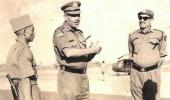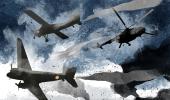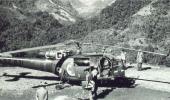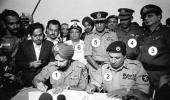What does a fighter pilot feel as he takes off and lands his battle-ready aircraft? Air Commodore Nitin Sathe (retd) takes you through those emotions.
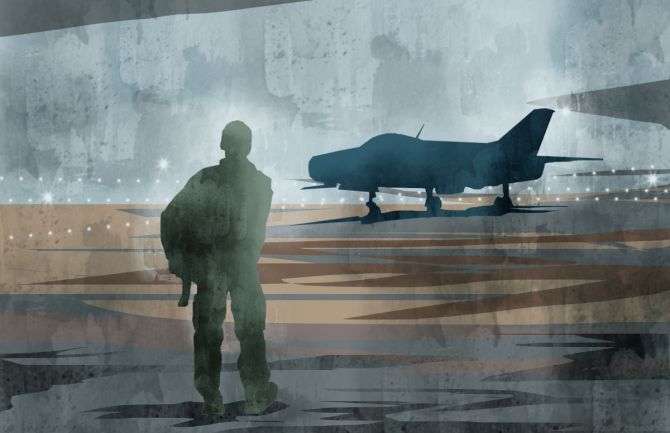
'Aircraft (Callsign) 254 finals...
'Three greens (meaning undercarriage is down)...
'Full flaps (flaps are down)...
'ATC-254 cleared to land...
'Winds 10 o'clock, 5 knots...'
In the dark of the night, I get the clearance to land.
I am around 700 feet above Mother Earth and should, God and aircraft willing, be on terra firma in a few seconds.
The two lines of lights along the runway edges are like diamonds that shine through the dark haze, helping me align my aircraft for a touchdown.
As I descend on the glide path towards the touchdown point, the lights separate out and become parallel lines meeting at infinity.
The adrenalin that kicked in some time ago has kept me alert and aware about what is happening in and around the aircraft.
One small mistake could prove costly for both man and machine.
This is my street. This is where I aviate from, day and night, in good and bad weather, doing a multitude of missions to keep our skies safe.
I love this street though it has no trees, no houses except for the ATC building at halfway point and soft, sand-filled ground at both ends.
And of course, the all-important 'arrester barrier' at the ends of the runway, ready to 'arrest' my aircraft should my brakes fail during landing or I abort my take-off for any reason.
Every time I return from a mission -- whether to my home base or elsewhere -- it is always a joy to see the runway from afar. The elongated, rectangular piece of hard concrete beckons; reassuring me that it will always be there to receive me.
Once a while, in bad weather or during poor visibility, or when one is actually lost, this street becomes elusive.
As one looks for it using all possible means, heart-in-mouth, panic unsettles the best of the best. Is there any pilot who hasn't had this feeling at some point in his aviating career? I think not.
But once you see the glimmer of the lights at the edge of the runway, your breath eases and the stress drains out of your body.
Before I come onto my street to take off, there are a few beautiful and exciting moments I can't help writing about.
Let's begin with the flight complex, from where you will start your journey.
You have worked hard preparing for the mission planned for you.
To ensure zero error, you study the maps in detail, go over the additional checks, procedures and drills specific to the mission and revise emergency actions to cater to contingencies.
After all, combat pilots prepare for the worst when they do their best, don't they?
Then, before you stride to the aircraft, a detailed briefing on the boards and charts removes all lingering doubts.
This done, you pick up your helmet and sign for the mission, as well as for the aircraft allotted to you, in the 'flight authorisation book'.
Walking to your aircraft with the helmet tucked under your arms and your oxygen mask draped like a snake over your shoulders, you mull over the sortie to be flown.
The silent aircraft awaits you in the parking bay. As you reach closer, a crisp welcome salute by the ground crew brings you back into the present.
You do a quick run through check of your maps, survival kit, weapon, first aid kit and all such knick-knacks that go into the many pockets of your overalls.
Keeping the helmet on the aircraft wing, you don your oil-and-grease-stained chamois leather gloves and go around the aircraft to carry out the pre-flight inspection.
As you walk around, you touch the machine at its nerve points, caressing the skin just as you would your horse before a ride.
The cold metal is soothing to the touch and you seem to be transmitting some of your energy into it.
Climbing sprightly into the cockpit with the help of the ladder positioned for you, you jump inside, both legs straddling the joystick, quickly scanning around for foreign objects.
The parachute-filled hard seat welcomes you and your legs go instinctively onto the rudder pedals.
Before you know it, your hands have picked up the straps around your thighs; the ground crew helps with those around your shoulders.
You are snug, tight and tied to the parachute and the aircraft.
With the helmet on and the oxygen and mikes connected, the man-machine interface is complete. You are the aircraft now.
Your job commences inside the cocooned environment.
With a shudder, the engine whines to life and the aircraft awakens from slumber.
The instrument needles start moving.
Some lights flash in the cockpit while some go off, indicating that 'she' and her systems are behaving the way they should.
We always refer to the aircraft as a 'she'. Why so? Well, that's a story for another time.
The chocks on the wheels are removed and the aircraft is given a final check by the technicians on the tarmac.
With an increased whine from the engine, the aircraft lurches forward along the taxiway.
The nose bucks in as you check the brakes, as if saluting the technicians who got the aircraft ready for flight.
A few narrow by-lanes would need to be traversed before you reach the 3000-odd metre street called the runway.
It is as if you are standing at one end of a long foot rule.
The white unbroken lines on the sides and the broken lines along the centre merge into the haze and seem to lead into the skies above.
You will soon be there, prancing around moving in all dimensions.
The adrenalin kicks in.
You rehearse actions that you will take if you have to abandon take-off or have to eject out of the airplane due to any reason.
'Cleared for take-off,' radios the ATC. It is like waiting at a signal in a Ferrari, waiting for the light to turn green.
Full power on, check if all is well with the airplane one last time by glancing at the instruments before you release the brakes.
She surges forward with the bountiful energy released by the engine.
You are pushed backwards into the seat.
This feeling of acceleration is heavenly! You have learnt to love and bear many such horizontal and vertical 'G' forces when you throw the aircraft around during your missions.
Racing down the runway, you lift her off the ground. You are Jonathan Livingstone Seagull in the Richard Bach book.
Oh, what a feeling! Ecstasy. Pure E-C-S-T-A-S-Y.
Air Commodore Nitin Sathe retired from the Indian Air Force in February 2020 after a distinguished 35 year career.
The author of three books, you can read Air Commodore Sathe's earlier contributions here.
Feature Presentation: Rajesh Alva/Rediff.com

